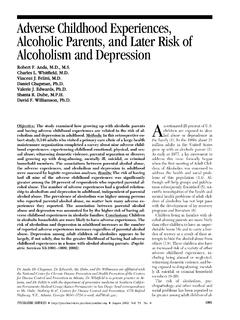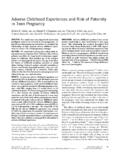Transcription of The Neurobiology of Trauma - Reach Counseling
1 The Neurobiology of Trauma Dr. Casey Hanson Sherman Counseling April 12, 2017 Disclaimer: This presentation includes examples, discussion and video which may be triggering to audience members. We each have our own history and pathways. Please feel free to exit the presentation at any time. The presenter will remain available after the presentation for any concerns or questions Training Objectives Synaptic Activity, Neurotransmitters, Nervous system responses, and Brain Structures associated with stress and Trauma . How traumatic events impact an individual s emotional and behavioral presentations. How the brain processes and recalls traumatic events. The developing brain, adverse childhood experiences, neuroplasticity and resilience. Trauma Alters How the Brain Works Most Neuronal development occurs after birth Genes provide the Basic blueprint Young brains are constantly Re-aligning neurons- at such a rate The adult brain could not match Science of Early Brain and Child Development Brain architecture is constructed by processes that begin before birth and continue into adulthood Skill begets skill as brains are built in a hierarchical fashion bottom up, increasing complex circuits and skills built on top of simple circuits and skills over time The interaction of genes and experience shapes the circuitry of the developing brain Shonkoff, 2002 The Brain Matters The human brain is responsible for everything we do.
2 Cry, laugh, walk, talk, create the brain is responsible for all. The brain - one hundred billion nerve cells in a complex net of continuous activity The brain s functioning is a reflection of our experiences. The Developing Brain Without healthy, safe, reciprocal relationships the brain s architecture does not form as expected, which can lead to disparities in learning and behavior. There are sensitive periods in which the brain is more susceptible to environmental inputs, these early experiences can have enduring effects, but the effects are amendable to change Weder & Kaufman (2011) indicate that despite previous belief that certain children with multiple or severe Trauma history are irrevocably damaged especially if Trauma occurred during critical periods is a myth Stress Real or imagined threat to physical or psychological integrity of an individual Beneficial when it is tolerable and of appropriate duration- leads to feelings of mastery/development When prolonged, severe, or recurrent it impairs coping abilities Allostasis is the ability to maintain homeostasis or stability through change- this suggests the ability to anticipate stressors versus merely reacting Katz et al.
3 2012 Allostatic load This is the failure or compromise of normal allostatic processes leading to chronic dysregulation For example secretion of cortisol is a healthy adaptive response to an acute stressor (allostasis) but chronic stress and high levels of cortisol (allosatic load) leads to secondary health problems Allostatic load- Quantified by measuring Cortisol, DHEA-S, and Norepinephrine and Epinephrine Early relationships and attachment may influence vulnerability to allostatic load The concept of allostatic load is directly linked into the ACES study In compared to a risk-reslience paradigm- the concept of allostatic load allows for composite that takes into account the significance or early traumatic experiences that may cause a cascade of physiological and psychological changes.
4 Katz et al. (2012) Human Stress Response Fight or Fight response State of high alert Action, not thought Inability to think clearly Extreme thoughts Hypervigilance Attention to threat Intense and prolonged anxiety Drive to take action A DISASTER WHEN THIS BECOMES CHRONIC Stress Leads Damage to the neuroreceptors that control the stress response Increase of receptors for cortisol, with the result that it is easier to be triggered Chronically high levels of Cortisol and Adrenaline The Brain and adverse experiences Brain development and behavior occurs in an orchestrated manner The Hypothalamic Pituitary Adrenal Axis (HPA Axis) initiates stress response and promotes the release of glucocorticoids The Hippocampus is critical for slowing this response via glucocorticoid receptors The Stress Response The Reticular Activating System (RAS) The RAS plays a major role in arousal, anxiety, and the modulation of limbic and cortical processing.
5 These brainstem and midbrain monoamine systems, working together, provide the flexible and diverse functions necessary to modulate the variety of functions involved in anxiety regulation. Locus Coeruleus Involved in initiating, maintaining, and mobilizing the total body response to threat. The LC plays a major role in determining the value of incoming sensory information Acute stress results in an increase in LC activity. The LC plays a critical role in regulating arousal, vigilance, affect, irritability, locomotion, attention, the response to stress, sleep, and the startle response. Child Trauma Academy The Stress Response Hippocampus The hippocampus is critical to the process of learning. It takes short-term memory and converts it into long-term memory. It plays a major role in memory, including what we call episodic, declarative, and spatial learning and memory.
6 The hippocampus also plays a key role in various activities of the autonomic nervous and neuroendocrine systems. Stress hormones and stress-related neurotransmitter systems have the hippocampus as a target. Various hormones ( , cortisol) appear to alter hippocampus synapse formation, thereby causing actual changes in gross structure and size. Repeated stress inhibits the development of neurons and atrophy of the hippocampus can occur. These neurobiological changes are related to some of the problems with memory and learning found in stress-related neuropsychiatric syndromes, including post-traumatic stress disorder (PTSD). Child Trauma Academy The Stress Response Sapolsky, 2004 Child Trauma Academy Amygdala the key brain region in the processing, interpreting, and integration of emotional functioning.
7 The amygdala is where fear learned from past experience is permanently stored. The amygdala receives input directly from sensory systems throughout the brain. The amygdala processes and determines the emotional value of simple sensory input, complex multisensory perceptions, and complex cognitive abstractions. The amygdala orchestrates the response to this emotional information by sending projections to brain areas involved in motor (behavioral), autonomic nervous system, and neuroendocrine areas of the CNS. Fearful situations stimulate the brain to activate the sympathetic nervous system and adrenal glands causing the release of stress neurotransmitters and hormones. These chemicals activate the "flight or fight" response which includes an increase in heart rate to facilitate the delivery of blood to working muscles.
8 The Stress Response Cortex The quality and intensity of any emotion, including anxiety, is dependent upon subjective interpretation or cognitive appraisal of the given situation. How an individual cortically interprets the limbic-mediated activity ( , their internal state) associated with arousal plays a major role in the subjective sense of anxiety. Neurotransmitters Everything we do relies on neurons communicating with one another. Electrical impulses and chemical signals carrying messages across different parts of the brain and between the brain and the rest of the nervous system. Neurotransmitters send chemical messages between neurons Important neurotransmitters in cortical regions are GABA and glycine. The capacity of benzodiazepines to alter arousal and sensitivity to threat has long been known.
9 The principle pharmacological treatment for many anxiety disorders involves benzodiazepine treatment, targeting GABA receptor complexes. Different types of acute stress result in increased 5-HT turnover in the medial prefrontal cortex (mPFC), Exposure to repeated stress within a learned-helplessness model resulted in a decrease of 5-HT release in the frontal cortex (possibly reflecting 5-HT depletion by continued release). Oxytocin Neumeister ( 2006), NIMH Brain Basics Responses During Trauma Fight Freeze Surrender Flight Automatic Defense Mechanisms Traumatic Stress Experiences Re-experiencing A child responding to a Trauma reminder may hide, withdraw, shake or freeze Everyday classroom experiences may be triggering such as a bell sounding, door slamming, peer yelling Hyperarousal Children may be on alert following traumatic experiences Children may be hypersensitive and interpret threat that is not present Avoidance Children may become intentionally detached to avoid re- experience of past Trauma May appear aloof, disinterested.
10 Or non compliant Traumatic Bereavement/grief Preoccupation with traumatic loss which inhibits ability of typical grieving process Hypersen-sitivity to even minor threat Extremist thinking Responds to many things as threat to life aggression and impulse control Attention to threat while ignoring less threatening, but important information Trauma Alters the Way the Brain Works Principles of Neurodevelopment The brain is underdeveloped at birth The brain organizes from the bottom up - brainstem to cortex and from the inside out Organization and functional capacity of neural systems is sequential Experiences do not have equal influence throughout development (sensitive periods) The Brain/ Trauma Response Homo Sapiens - Verbal expression; conscious thought; self awareness Mammalian - Emotion & feeling & memory Reptilian - Sensation & impulse & instinctive response Bruce Perry , 1997 Hierarchy of Brain Function In the brain of someone who has experienced a variety of emotional, behavioral and cognitive stimuli, a top heavy ratio develops.



